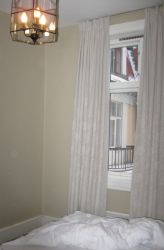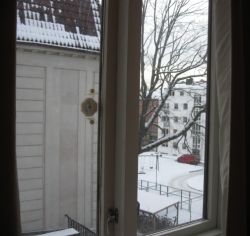 |
 |
||||||||
Small DifferencesDecember 08, 2010 In my jeans, boots, and old blue parka, I didn't look out of place on the streets of Oslo. The people on the streets and buses of Oslo looked so familiar that it was a little startling to realize that I couldn't eavesdrop on their conversations. Most of them, however, could have eavesdropped quite well on any conversation I had in English. Signs I could often decipher. "Julmarked" and "God jul" weren't hard. But "Lufting av hund er forbudt"? "Hund" and "forbudt" were easy, but didn't "luft" have something to do with air? Indeed it did. If you don't want a dog to do its business on your sidewalk, fence, or flowerbed, you post a sign warning that airing dogs is forbidden. Lynn met me at the airport, I changed US$100 into 500 Norwegian kroner (NOK), and we took the airport train into town, to "Oslo S," the central railway station. Across the fields the snow-gilded firs were straight out of a picture postcard; they looked the same when I left almost a week later. Riding the train was just as amazing. You swipe your credit card once at the beginning of your trip and again when you exit the station at your destination. No money changes hands, no change need be made -- and once you register with Flytoget, which runs the train, you can download a receipt for your journey. One-way passage was 170 NOK, or about $28.35. More expensive than the regular bus, but who wants to wrestle two suitcases and a laptop on a regular bus? We took a taxi from Oslo S to Gabelshus, my hotel, on Gabelsgate in the upscale embassy district. My room wasn't ready yet, so we left my bags in the office and went walking. Lynn guided me through the purchase of a bus pass, good for one week's unlimited travel on buses, streetcars, or the tube. It cost 210 NOK, about US$35. What a wonder. There are card readers on most of the buses: you swipe the front of the card over the reader and the reader logs you in/on. Again, no cash changes hands. The big difference between Oslo and the U.S. cities I know best, D.C. and Boston, wasn't the language; it was the nearly complete absence of cash from day-to-day transactions. And checks. On Martha's Vineyard, checks are generally accepted (maybe this is a small-town thing?), but I'm using them a lot less than I was two years ago. I use a debit card for groceries and at the post office; I pay most of my bills electronically. The Norwegians, and Europeans generally, are way, way ahead of us on this one. In Oslo I paid cab drivers with a credit card, bought meals and museum admissions and various goods with a credit card. My slippers required cash, and so did my bus pass, but that was about it. I don't know if my debit/ATM card would have worked in the local ATM/minibanks because I didn't need more cash than I'd got at the airport on arrival. My hotel room included buffet breakfast, which I took advantage of all three mornings I was there, and supper, which I only had on my first night. The food was very good, and the bread was excellent. (All the bread I ate in Norway was excellent -- and that's the verdict of a bread baker.) My room itself was cozy and complete, more like a room than a hotel room. The bed was made up with a sheet, duvet and cover, and one pillow. (Inn on the Square in Falmouth had four pillows on each bed.)
My hotel room, like just about every indoor space I was in, was considerably warmer than the average indoor space at home. At home I expect to have a couple layers of clothing on indoors this time of year. In Norway, I'm told, the idea is that the indoor temperature should be conducive to wearing only a T-shirt. I did indeed see people wearing not much more than that. Norway, I'm also told, has mostly clean energy, from hydroelectric power, so this may be part of the reason. I don't know what Norwegians pay for heat in the winter, and I wasn't there long enough to know if they talk about the cost of heat anywhere near as much as people at home do.
That was the view from my window. There was a little snow on the ground when I arrived, and a little snow on the ground when I left, but it didn't snow while I was there.
|
|||||||||
Home - Writing - Editing - About Susanna - Bloggery - Articles - Poems - Contact Copyright ©
Susanna J. Sturgis. All rights reserved. |
|||||||||



